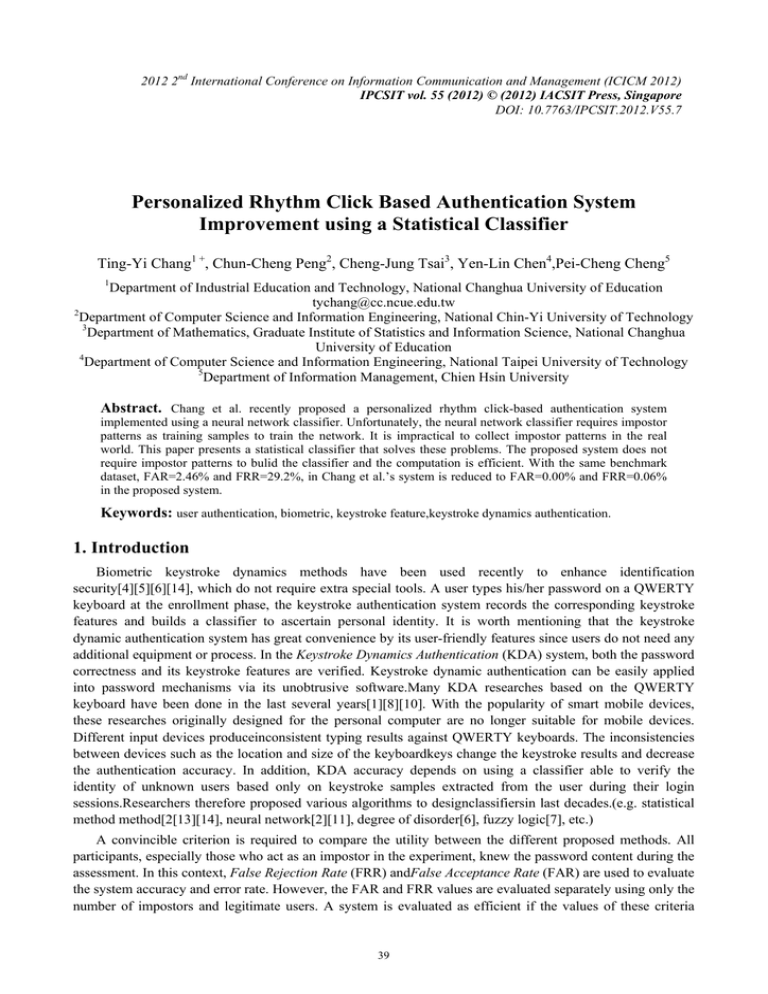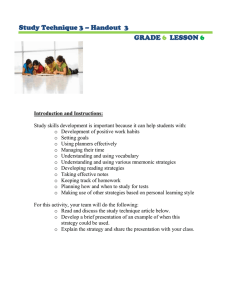Document 13136233
advertisement

2012 2nd International Conference on Information Communication and Management (ICICM 2012) IPCSIT vol. 55 (2012) © (2012) IACSIT Press, Singapore DOI: 10.7763/IPCSIT.2012.V55.7 Personalized Rhythm Click Based Authentication System Improvement using a Statistical Classifier Ting-Yi Chang1 +, Chun-Cheng Peng2, Cheng-Jung Tsai3, Yen-Lin Chen4,Pei-Cheng Cheng5 1 Department of Industrial Education and Technology, National Changhua University of Education tychang@cc.ncue.edu.tw 2 Department of Computer Science and Information Engineering, National Chin-Yi University of Technology 3 Department of Mathematics, Graduate Institute of Statistics and Information Science, National Changhua University of Education 4 Department of Computer Science and Information Engineering, National Taipei University of Technology 5 Department of Information Management, Chien Hsin University Abstract. Chang et al. recently proposed a personalized rhythm click-based authentication system implemented using a neural network classifier. Unfortunately, the neural network classifier requires impostor patterns as training samples to train the network. It is impractical to collect impostor patterns in the real world. This paper presents a statistical classifier that solves these problems. The proposed system does not require impostor patterns to bulid the classifier and the computation is efficient. With the same benchmark dataset, FAR=2.46% and FRR=29.2%, in Chang et al.’s system is reduced to FAR=0.00% and FRR=0.06% in the proposed system. Keywords: user authentication, biometric, keystroke feature,keystroke dynamics authentication. 1. Introduction Biometric keystroke dynamics methods have been used recently to enhance identification security[4][5][6][14], which do not require extra special tools. A user types his/her password on a QWERTY keyboard at the enrollment phase, the keystroke authentication system records the corresponding keystroke features and builds a classifier to ascertain personal identity. It is worth mentioning that the keystroke dynamic authentication system has great convenience by its user-friendly features since users do not need any additional equipment or process. In the Keystroke Dynamics Authentication (KDA) system, both the password correctness and its keystroke features are verified. Keystroke dynamic authentication can be easily applied into password mechanisms via its unobtrusive software.Many KDA researches based on the QWERTY keyboard have been done in the last several years[1][8][10]. With the popularity of smart mobile devices, these researches originally designed for the personal computer are no longer suitable for mobile devices. Different input devices produceinconsistent typing results against QWERTY keyboards. The inconsistencies between devices such as the location and size of the keyboardkeys change the keystroke results and decrease the authentication accuracy. In addition, KDA accuracy depends on using a classifier able to verify the identity of unknown users based only on keystroke samples extracted from the user during their login sessions.Researchers therefore proposed various algorithms to designclassifiersin last decades.(e.g. statistical method method[2[13][14], neural network[2][11], degree of disorder[6], fuzzy logic[7], etc.) A convincible criterion is required to compare the utility between the different proposed methods. All participants, especially those who act as an impostor in the experiment, knew the password content during the assessment. In this context, False Rejection Rate (FRR) andFalse Acceptance Rate (FAR) are used to evaluate the system accuracy and error rate. However, the FAR and FRR values are evaluated separately using only the number of impostors and legitimate users. A system is evaluated as efficient if the values of these criteria 39 incline towards zero, making FAR inversely proportional to FRR. These two rates vary according to the sensitivity level of the algorithm applied to the system. Therefore, a threshold value is often used as a system security tradeoff. The data quality is also an important factor in adopting keystroke dynamics. Because human behavior is a complex andunpredictable system of attributes, Hwang et al. [10] proposed three primary measures of data qualityfor consideration before adopting keystroke dynamics. Their research applied artificial rhythms and cues to assist user typing to improve discriminability. They used metronome audio to make artificial rhythms to improve the uniqueness, as well as asking the user to pause during their inputs to improve the consistency. They also proposed five typing strategies to improve the data quality[10].The sample made by the five typing strategies produced higher quality than the user’s natural rhythm which did not apply any pauses or cues. According to Hwang’s experiments, using pauses with cues produced the best performance. These typing strategies are more effective in those whose typing abilities are poor. Although these typing strategies improved the data quality with so many benefits, here are several problems that should be considered. First, typing strategies are not a user-friendly design. For example, users need to remember not only the password but also the locations and lengths of the pauses. Secondly, musical rhythm and slow tempo are implemented by a metronome which should be prepared before adopting. Although today’s hardware devices are sufficient to offer software with a similar function as an alternative, it should still be considered that some places do not allow voices. Finally, different input devices cause typing pattern inconsistencies. For instance, producing a typing pattern on a conventional keyboard or on handheld mobile device will produce different results by the same person. These different results are affected by the size of the keys on keyboard.Motivated to correct these weakness, Chang et al. [2] proposed a personalized rhythm click-based authentication system. Unlike Hwang et al.’s method, Chang et al. purposed the click feature method to solve the inconsistency issue between various devices. This click feature could be effective on a conventional keyboard, mouse or touch screen of a handheld mobile device such as a personal digital assistant or smart phone. This method was implemented by asking every participant to click the same private rhythm named “Encourage with Love”. The click features are extracted from the user as his/her feature sample.Although this personalized rhythm click method can improve the consistency between samples and solve device inconsistency, Chang et al.’s method has two main drawbacks. First, it is impractical to collect impostor patterns in the real world. Secondly,their system requires complex computation for training the neural network. This paper proposes a statistical method to build a classifier that requires only legitimate user training samples to construct the classifier. The computing complexity of the proposed system is lower than [2][11][12] by adopting the personalized statistical template method established in the training phase. This method requires data only from the legitimate user to build the classifier. When a user enrolls the system only his/her statistical template will be constructed without the need for data from other users’ in the system. Finally, in the experiment results, FAR=2.46% and FRR=29.2% in Chang et al.’s system are reduced to FAR=0.00% and FRR=0.06% in the proposed system. 2. Methodology Enrolment phase: In the enrolment phase, a user registers his/her personalized private rhythm. For evaluating the system utility, all users click the same target rhythm. The system extracts the click rhythm features to form feature samples. There are four combinations of up and down events for click rhythm features comprised as follows: • Down-up (DU): the time interval between the pressure and release of the same click event on a mouse button. • Down-down (DD): the time interval between two successive pressure events. • Down-up (UD): the time interval between the mouse button releases to the next mouse button being pressed. DU, DD and UD combination is used to form the feature samples. Let x , represent the feature value of ith click of the mth sample made by user x. For instance, “Encourage with Love” includes 11 clicks. Values of 11 DU, 10 DD and 10 UD are involved in the sample of user x. The click rhythm features adopted in this paper are given by , for = 1 to , = 1 to and , , for = 1 to , = 1 to − 1, where k is , , , 40 the number of clicks and n denotes the number of training samples. These click features formed a feature sample for each user entry, including 3k–2 =3×11–2=31 feature values. Training phase: After collecting the data in the enrolment phase, these feature samples are applied to train a classifier. A novel statistical classifier method is proposed to deal with impostor samples in the real world and decrease the number of computations by adopting a personalized statistical template. With this method, only the feature samples of a legitimate user are collected to build his/her template. The template is used to compute a score with samples generated from each login attempt. A most applicable threshold value α applied to our system is measured via Receiver Operating Characteristic curve [9]. The value α is a benchmark for judging the user identity. Furthermore, the personalized statistical template is built according to the legitimate users’ samples by computing the following values: • Step 1: Compute the maximum value of DU, DD and UD for the m samples of user x from Eq. (1), minimum value from Eq. (2) and mean value from Eq. (3). • Step 2: Compute the standard deviation of DU, DD and UD from Eq. (4). = max , =1 to = max = max , for = 1 to , =1 to = , for = 1 to , =1 to , for = 1 to = −1 = (1) = 1 min min =1 to 1 , for = 1 to , , for = 1 to , =1 to = −1 min =1 to , , for = 1 to −1 , , for = 1 to −1 (2) , − , for = 1 to , − , for = 1 to − 1 (4) , − , for = 1 to −1 =1 =1 = 1 , , for = 1 to −1 (3) = 1 =1 = =1 1 , , for = 1 to −1 = =1 1 =1 • Step 3: Generate the personalized statistical template composed of function fDU, fDD, andfUD using the results from Steps 1 and 2. fDUis generated by ithDU of every samples of user x, as shown in Eq. (5). Likewise, based on the results from Steps 1 and 2, fDDandfUDare formed (DD and UD replace DU in Eq. (6) respectively) asEqs. (6) and (7). 0 − −1× = − 1 +3× +3× , for +3× − 0 +3× − +1× ≤ +3× , for +3× ≤ ≤ −1× , for −1× ≤ ≤ +1× , for +1× ≤ ≤ +3× , for +3× ≤ (5) As a result, if the private rhythm includes k clicks, the system will generate 3k-2 functions to form a personal statistical template for each user. The system would store all users’ personalized statistical templates using Step 1 to Step 3. Authentication phase:Once an unknown user attempts to login as user x, the system would extract his/her click rhythm features from the sample that he/she provided. The system then verifies the clicked target rhythm by examining the number of features. As described in the enrolment phase, a legal click rhythm should have 11 DU, 10 DD and 10 UD involved. If the unknown user failed in this verification, the system would offer a second chance. Each user has two opportunities to provide his/her click rhythm for target rhythm verification. After the click rhythm verification, the system would continuously authenticate the unknown user by verifying the extracted click features through his/her personalized statistical template which acquired on training phase. ∗ ∗ ∗ ∗ ∗ ∗ ∗ ∗ ∗ ∗ ∗ ∗ Let = , ,…, , = , ,…, and = , ,…, beth 1 2 1 2 1 2 −1 −1 e click features extracted from the unknown user sample. These click features would be substituted into Eq. (8) to obtain a score as the benchmark for verifying the user.Finally we include a constant α for the score 41 threshold using ROC curve. If the score = (DUsum +DDsum + UDsum) / 3 is smaller than the value α, the system will offer a second chance for the unknown user to reenter again. Once the user fails on his/her second attempt, the system denies access from that user and labels him/her an impostor. Otherwise, the unknown user is judged a legitimate user. = ∑ =1 ∗ , for = 1 to , −1 = ∑ =1 ∗ , for = 1 to − 1, −1 = ∑ =1 ∗ , for = 1 to − 1 (8) 3. Experiment results Comparing our method to others, the same dataset is used to calculate FAR and FRR. We give special thanks to Chang et al. for providing the raw dataset from their experiment. There were 25 participants, with each clicking the private rhythm 30 times to generate 30 samples, producing 25×30 samples overall. For every sample set from each user, 10 of 30 samples were randomly captured as the training sample to form the personalized statistical template. The last 20 samples (25×20=500 legitimate samples) were used to examine the system to obtain FRR. Each user was attacked by all others. These test samples were applied to calculate FAR, in addition to the samples against user’s own (24×20=480 impostor samples). The result shows that FRR and FAR achieved 0.06% and 0.00%. Table 1 shows a comparison between this paper and Chang et al.’s [4] results based on the same dataset. In Table 1, with the same dataset employed, our results are better than Chang et al.’s for FRR or FAR. Table 1.A comparison sheet of classifier performance with the same dataset Classifier Statistic(this paper) Neuralnetwork [2] FAR (%) 0.00 0.06 FRR (%) 2.46 29.2 Numbers of training sample 250 490 System Overall threshold (α) 0.6 0.03 4. Conclusion The proposed approach requires only legitimate samples into account, calculating the maximum, minimum, mean and standard deviation of registered samples to build the classifier. Finally, FAR and FRR are decreased to 0.00% and 0.06%, respectively. The proposed statistical algorithm has lower computational load which can enable this rhythm click-based authentication system to work on low computational handheld devices. to the proposed method improves the synergistic reinforcement of password mechanisms with rhythm click-based authenticaiton on various devices perfectly. 5. Acknowledgment This research was partially supported by the National Science Council, Taiwan, ROC, under contract nos.: NSC100-2221-E-018-025 and NSC100-2221-E-018-034. 6. References [1] Campisi P., Maiorana E., Bosco M. L. and Neri A., "User authentication using keystroke dynamics for cellular phones," IET Signal Processing, Vol. 3, No. 4, pp. 333-341, 2009. [2] Liu C. L., Chang T. Y., Chiang M. L. and Tsai C. J., ''A Simple Keystroke Dynamics-Based Authentication System using Means and Standard Deviations,'' Journal of Internet Technology, vol. 13, no. 3, pp. 439-444, 2012. [3] Chang T. Y., Yang Y. J. and Peng C. C., "A personalized rhythm click-based authentication system," Information Management & Computer Security, Vol. 18, No. 2, pp. 72-85, 2010. [4] Chang T. Y., Tsai C. J. and Lin J. H., "A Graphical-based Password Keystroke Dynamic Authentication System for touch Screen Handheld Mobile Devices," Journal of Systems and Software, Vol. 85, No. 5, pp. 1157-1167, 2012. [5] Cheng P. C., Chang T. Y., Tsai C. J., Li J. W. and Wu C. S., "A Novel and Simple Statistical Fusion Method for User Authentication through Keystroke Features," Convergence Information Technology, Vol. 6, No. 2, pp. 347356, 2011. 42 [6] Choras M. and Mrooczkowski P.,, "Keystroke Dynamics fo or Biometricss Identificatioon," Adaptive and Naturall Computting Algorithm m, Vol. 4432, pp. 424-431, 2007. [7] De Ru W. W G. and Elooff J. H. P., "E Enhanced passsword authenttication througgh fuzzy logicc," IEEE Expeert: Intelligentt Systemss and their App pplications, Vool. 12, No. 6, pp. 38-45, 1997. [8] Enzhe Y. and Sungzoon C., "Keeystroke dynaamics identity y verification---its problemss and practiccal solutions,"" Computters & Securitty, Vol. 23, Noo. 5, pp. 428-4440, 2004. [9] Fawcettt T., "An introoduction to RO OC analysis," Pattern Reco ognition Letterrs, Vol. 27, Noo. 8, pp. 861-8 874, 2006. [10] Hwang S. S., Lee H. H J. and Choo S., "Improving authentication accuraccy using artifiicial rhythms and cues forr keystroke dynamics--based authenntication," Exppert Systems with w Applicattions, Vol. 366, No. 7, pp. 10649-10656,, 2009. [11] Ku W. C., "Weaknnesses and drawbacks d of a password authenticatioon scheme uusing neural networks forr multiserrver architectuure," IEEE Trransactions onn Neural Netw works, Vol. 16, No. 4, pp. 10002-1005, 200 05. [12] Lee H. J. and Cho S., "Retraining a keystroke dyynamics-baseed authenticatoor with imposttor patterns," Computers & Securityy, Vol. 26, Noo. 4, pp. 300-3310, 2007. [13] Teh P. S., Teoh A. B. B J., Ong T. S. and Neo H. F., "Statistical fusion approach a on kkeystroke dynaamics," IEEE E Confereence on Signaal-image Technnologies and Internet-based I d System, pp. 918-923, 2008. [14] Zhang Y., Y Chang G.., Liu L. and Jia J., "Autheenticating Useer's Keystrokee Based on Sttatistical Mod dels," Geneticc and Evoolutionary Coomputing, pp. 578-581, 20100. Tin ng-Yi Changg received his MS from the Graduatte Institute oof Computer Science andd Infformation Enggineering at Chhaoyang Univ versity of Techhnology, and his PhD in th he Departmentt of Computer Sccience at Nattional Chiao Tung University (2003-22006). Curren ntly, he is ann ogy, Nationall asssociate professsor with the Department of Industriall Education aand Technolo Changhua Univeersity, Taiwann. His curren nt research intterests includde artificial in ntelligence, e-mation securityy, cryptograph hy, and mobilee communicattions. Leaarning, inform Chu un-Cheng Peeng has a Daatabase Develo opment from the Computeer Science and d Informationn Mannagement Deepartment of the Provideence Universiity, Taiwan, a MSc (DN NA Sequencee Prediction) from the Computerr Science and Information Engineering E D Department of the Chaoyangg P (Neural Networks N Leaarning) from the t Computerr Uniiversity of Teechnology, Taaiwan, and a PhD Scieence and Infoormation Systtems Departm ment of the Biirkbeck Colleege, Universitty of London,, Enggland. His research interests are mainly in i nonmonotoone learning, uunconstrained optimization,, recuurrent neural networks n and artificial a intellligence appliccations. Cheeng-Jung Tsaai received thhe BS degree in mathematiics and sciencce education from f Nationall Pingg Tung Univversity of Eduucation in 19 995, the MS degree in innformation ed ducation from m Nattional Universsity of Tainan in 2000, and the PhD degrree in computter science and informationn enggineering from m National Chiiao Tung Univ versity in 20088. Currently, hhe is an Assistant Professorr in thhe Graduate Institute I of Staatistics and In nformation Sciiencethe, Natiional Changhu ua University,, Taiw wan. His curreent research innterests includ de data miningg, information security, and e-learning. Yen n-Lin Chen received r the B.S. B and Ph.D D. degrees in electrical andd control engiineering from m Nattional Chiao Tung T University, Hsinchu, Taiwan, T in 2000 and 2006, respectively. He is now ann Asssociate Professor at the Deept. of Comp puter Science and Informattion Engineerring, Nationall Taippei Universityy of Technology, Taipei, Taaiwan. His ressearch interestts include imaage and videoo proccessing, patteern recognitioon, embedded d systems, document imagge analysis, an nd intelligentt trannsportation sysstems. Peii Cheng Cheeng received the Ph.D. degree d in Com mputer Sciennce and Engiineering from m NattionalChiao Tung T University (NCTU), HsinChu, Taaiwan in 20066. Now he iss an assistantt proofessorof the Department D off Information Management, M ChienHsin Unniversity, Tao oyuan, Taiwann. Hisscurrent reseearch interestts include content-based c image retrrieval, machiine learning,, knoowledgemanaggement, and artificial a intelliigence. 43







